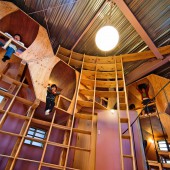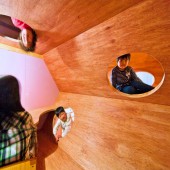Beehive House Family Home by Satoshi Higashijima |
Home > Winners > #69099 |
 |
|
||||
| DESIGN DETAILS | |||||
| DESIGN NAME: Beehive House PRIMARY FUNCTION: Family Home INSPIRATION: Inspiration comes from two sources. Firstly, the internal space is based on the structure of the beehive. Secondly, the clients are Japanese Castle enthusiasts so the facade and plan of of the interior is based on a Japanese castle. UNIQUE PROPERTIES / PROJECT DESCRIPTION: First, the internal space has no enclosed rooms and is comprised of a living space and a beehive structure. Second, the house is based on the concept of the "honmaru" and the "jokamachi" OPERATION / FLOW / INTERACTION: The beehive house is designed to stimulate the family both physically and mentally. The beehive spaces let the kids move upwards or downwards through the inter-connecting holes. They can even move between floors. There are basically two main floors to the house but the various spaces are located on different levels. There are no dead-ends. To move freely and have a varied environment stimulates your brain, especially for kids. I hope by stimulating the kids' brains in their everyday environment for a few hours each day it will have a huge effect over several years. PROJECT DURATION AND LOCATION: The project started in January 2009 and was finished in February 2011. The house is located in Shioya, Hyogo Prefecture, Japan. FITS BEST INTO CATEGORY: Architecture, Building and Structure Design |
PRODUCTION / REALIZATION TECHNOLOGY: The beehive structure was designed to look like a real beehive. The carpenter crafted hexagon shapes that interconnected with round holes to allow movement between the spaces both vertically and horizontally. One can even move between the first and second floors. Once inside the beehive it is possible to lose sense of where you are. SPECIFICATIONS / TECHNICAL PROPERTIES: The beehive structure is built from plywood and comprises of 12 separate cells. TAGS: brain stimulation, beehive house, kids' development, mental and physical stimulation, RESEARCH ABSTRACT: My ideas for this project are based on watching my own 3 kids. I noticed that they were like sponges, absorbing everything that was said and copying it. As an architect it made me think of how they absorb information that is not language. In particularly, the environment that they live in. I noticed how they move around our house, taking shortcuts, or moving through spaces that were not meant to be thoroughfares. I realised that kids get bored with the sameness in the house. This made me think about how movement between spaces can stimulate the brain. Also, how spaces themselves can be designed to stimulate our brains. CHALLENGE: The challenge of this project was trying to explain to the client something that they had never seen or experienced before. The concept was unusually unusual. On top of that finding a builder who was creative enough to make something new, something that is not a box was a challenge. ADDED DATE: 2018-06-24 15:56:40 TEAM MEMBERS (1) : IMAGE CREDITS: Image #1 Kazushi Hirano Image #2 Kazushi Hirano Image #3 Kazushi Hirano Image #4 Kazushi Hirano Image #5 Kazushi Hirano |
||||
| Visit the following page to learn more: http://bit.ly/2wct39M | |||||
| AWARD DETAILS | |
 |
Beehive House Family Home by Satoshi Higashijima is Winner in Architecture, Building and Structure Design Category, 2018 - 2019.· Read the interview with designer Satoshi Higashijima for design Beehive House here.· Press Members: Login or Register to request an exclusive interview with Satoshi Higashijima. · Click here to register inorder to view the profile and other works by Satoshi Higashijima. |
| SOCIAL |
| + Add to Likes / Favorites | Send to My Email | Comment | Testimonials | View Press-Release | Press Kit |
Did you like Satoshi Higashijima's Architecture Design?
You will most likely enjoy other award winning architecture design as well.
Click here to view more Award Winning Architecture Design.








